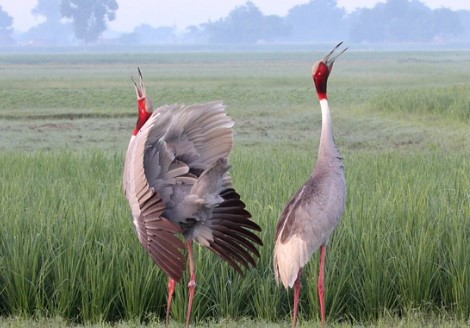Sarus Crane
2023 MAR 30
Preliminary >
Environment and Ecology > Biodiversity > Species in news

Why in news?
- Recently a man from Uttar Pradesh, was booked under the Wildlife Protection Act, 1972, for “illegally” keeping and nursing an injured Sarus crane (Grus Antigone) he found in his village.
About Sarus crane:
- The Sarus crane is usually found in wetlands
- Standing at 152-156 centimetres, it is the world’s tallest flying bird.
- The birds are predominantly gray, with long, pale red legs.
- They are seen in Australia, Cambodia, China, India, Laos, Myanmar, Nepal, Pakistan, Vietnam and Bangladesh.
- In the Indian subcontinent, it is found in northern and central India, Terai Nepal and Pakistan.
- It is the state bird of Uttar Pradesh.
- According to World Wildlife Fund (WWF), their population is now on the decline with only 15,000-20,000 in India (a majority of which are in UP).
Habitat:
- The Sarus crane is known for its ability to live in association with humans, inhabiting open, cultivated, well watered plains, marshlands and jheels.
- These birds nest on the ground. A bulky nest is formed from wetland vegetation.
Threats:
- Sarus cranes are threatened mainly by loss of habitat, due to drainage of wetlands, agricultural expansion and human development.
- The use of pesticides, as well as collisions with wires also poses major threats.
- Cranes are also commonly targeted by humans hunting and egg collecting.
Conservation Status:
- IUCN- Vulnerable (VU)
- Wildlife (Protection) Act 1972- Schedule IV
- Species listed in Schedule IV are protected, but the penalties are much lower.
PRACTICE QUESTION:
With reference to ‘Sarus Crane’, consider the following statements:
1. It is usually found in wetlands
2. They are one of smallest flying birds in the world
Which of the statements given above is/are correct?
(a) 1 only
(b) 2 only
(c) Both 1 and 2
(d) Neither 1 nor 2
Answer
